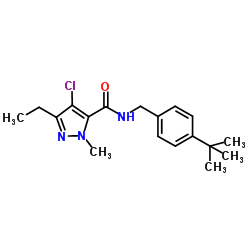Tebufenpyrad

Tebufenpyrad structure
|
Common Name | Tebufenpyrad | ||
|---|---|---|---|---|
| CAS Number | 119168-77-3 | Molecular Weight | 333.856 | |
| Density | 1.1±0.1 g/cm3 | Boiling Point | 468.4±45.0 °C at 760 mmHg | |
| Molecular Formula | C18H24ClN3O | Melting Point | 61-62ºC | |
| MSDS | Chinese USA | Flash Point | 237.1±28.7 °C | |
| Symbol |

GHS07 |
Signal Word | Warning | |
| Name | tebufenpyrad |
|---|---|
| Synonym | More Synonyms |
| Density | 1.1±0.1 g/cm3 |
|---|---|
| Boiling Point | 468.4±45.0 °C at 760 mmHg |
| Melting Point | 61-62ºC |
| Molecular Formula | C18H24ClN3O |
| Molecular Weight | 333.856 |
| Flash Point | 237.1±28.7 °C |
| Exact Mass | 333.160797 |
| PSA | 46.92000 |
| LogP | 3.90 |
| Vapour Pressure | 0.0±1.2 mmHg at 25°C |
| Index of Refraction | 1.565 |
CHEMICAL IDENTIFICATION
HEALTH HAZARD DATAACUTE TOXICITY DATA
|
| Symbol |

GHS07 |
|---|---|
| Signal Word | Warning |
| Hazard Statements | H302 |
| Personal Protective Equipment | dust mask type N95 (US);Eyeshields;Gloves |
| Hazard Codes | Xn:Harmful; |
| Risk Phrases | R22 |
| Safety Phrases | S36 |
| RIDADR | 2588 |
| RTECS | UQ6276400 |
| Packaging Group | III |
| Hazard Class | 6.1(b) |
| HS Code | 2933199012 |
| HS Code | 2933199012 |
|---|
|
First detection of chlorfenapyr (Secure) resistance in two-spotted spider mite (Acari: Tetranychidae) from nectarines in an Australian orchard.
Exp. Appl. Acarol. 31(1-2) , 131-4, (2003) Chlorfenapyr resistance (2.9- and 19.9-fold respectively at LC50 and LC99 level) was detected in Tetranychus urticae Koch causing control failure following a single application of product to nectarine... |
|
|
New developments in insecticide resistance in the glasshouse whitefly (Trialeurodes vaporariorum) and the two-spotted spider mite (Tetranychus urticae) in the UK.
Pest Manag. Sci. 58(2) , 123-30, (2002) A recent survey of insecticide resistance in two of the most problematic pests in UK glasshouses revealed some new developments. At least some individuals in all UK samples of Trialeurodes vaporarioru... |
|
|
Ultraviolet radiation increases sensitivity to pesticides: synergistic effects on population growth rate of Daphnia magna at low concentrations.
Bull. Environ. Contam. Toxicol. 87(3) , 231-7, (2011) In the present study we aimed to investigate whether UV-B radiation can exacerbate effects of pesticides fenoxycarb, pirimicarb, and tebufenpyrad on the survival, reproduction, and population growth r... |
| N-(4-tert-butylbenzyl)-4-chloro-3-ethyl-1-methylpyrazole-5-carboxamide |
| MFCD01632408 |
| 4-Chloro-N-(4-tert-butylbenzyl)-3-ethyl-1-methyl-1H-pyrazole-5-carboxamide |
| 4-Chloro-N-[[4-(1,1-dimethylethyl)phenyl]methyl]-3-ethyl-1-methyl-1H-pyrazole-5-carboxamide |
| T5NNJ A1 C2 DG EVM1R DX1&1&1 |
| N-[(4-tert-butylphenyl)methyl]-4-chloro-3-ethyl-1-methyl-1H-pyrazole-5-carboxamide |
| 1H-Pyrazole-5-carboxamide, 4-chloro-N-[[4-(1,1-dimethylethyl)phenyl]methyl]-3-ethyl-1-methyl- |
| N-[(4-tert-butylphenyl)methyl]-4-chloro-5-ethyl-2-methylpyrazole-3-carboxamide |
| 4-Chloro-3-ethyl-1-methyl-N-[4-(2-methyl-2-propanyl)benzyl]-1H-pyrazole-5-carboxamide |
| Tebufenpyrad |
| N-(4-(tert-Butyl)benzyl)-4-chloro-3-ethyl-1-methyl-1H-pyrazole-5-carboxamide |

